
|
|
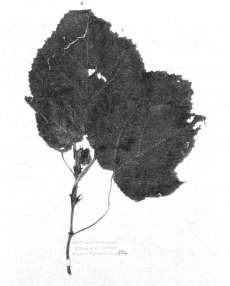 |
| Fig.1 Herbarium specimen of aute (paper mulberry, Broussonetia papyrifera) introduced to New Zealand from the Pacific by Maori. It was collected in the Bay of Islands in 1769 in the course of Captain Cook's first voyage to New Zealand. |
Just as important in adapting plants for their purposes, early maori extended their knowledge of Pacific Island plants to the new but related plants they found in Aotearoa. A good example of this is the kawa kawa (Macropiper excelsum). The doubling of the name provides linguistic evidence that early Maori saw it as similar to Piper, the source of the narcotic drink kava of Pacific Islands.
As the introduced plants were acclimatised to tropical conditions and could be grown only in the warmest parts of Aotearoa, Maori had good reason to try and domesticate native plants. However, as food plants they provided scant pickings. Firstly, there are no native annual grasses. Annual grasses are the parents of the major cereal crops on which the great civilisations of the world were founded.
Secondly, without regular extended seasonal extremes of cold or drought, native plants do not need large underground storage organs to support survival during these stressful periods. Such storage organs provide carbohydrate that is fundamental to human nutrition. Instead, beyond where kumara could be grown, Maori were dependent on aruhe, the root of bracken, for most of their carbohydrate. Preparing aruhe was laborious and the prepared product was not particularly palatable. In a sense Maori domesticated bracken by encouraging its growth by burning, and there is evidence that they recognised stands of the species that provided the best aruhe.
Thirdly, in the absence of land mammals, and especially primates, it is suggested that there was no cause for native plants to evolve the large fleshy fruits that humans find delectable. In a sense early Maori had to get used to bird tucker, as the flesh of birds was for a while at least abundant, and Maori made good use of fruit that nature had designed to be distributed by birds.
The karaka stands out as the most notable of these fruits, and Maori domesticated this species, both by cultivating it and learning how to remove the toxins from its seeds before eating them. Associated with this domestication was the Maori tradition that karaka was introduced to Aotearoa as cargo of the ancestral ocean voyaging waka. Scientific evidence is that it is a native plant, distributed beyond its natural range in New Zealand when it was cultivated by Maori (Molloy 1990).
An even more remarkable story is the Maori domestication of cabbage tree, the Cordyline of botanists and the ti of Polynesians, as a food plant. They applied their knowledge of the Pacific ti, Cordyline fruticosa, which they introduced, to the native Cordyline species they found in Aotearoa. Beyond the harvesting of wild plants, several levels of domestication were applied to this group of species.
In the eastern South Island in particular, Cordyline australis, ti kouka, was coppiced on a 3 to 4 year rotation and the harvested stems steamed for 24 hours in large umu ti to produce the sweetener kauru. Steaming converted the carbohydrate fructan in the stems to very sweet fructose. Material processed in this way was stored dry until the time came to add it to fern root and other foods to improve their palatability.
Waikato Maori cultivated ti rauriki, the grass-like northern cabbage tree (C. pumilio) for the sweet carbohydrate of its rhizomes. Even more remarkable is Cordyline 'Ti Tawhiti', a dwarf non-flowering selection of C. australis, that was cultivated by Maori. This plant was the subject of an intense discussion amongst the leading botanists of New Zealand at a meeting of the Royal Society here in Wellington 100 years ago. It was saved from extinction because its dwarf form found favour with gardeners and it came to be known as Cordyline 'Kirkii' recording the interest Thomas Kirk had in the plant. Its origin as a Maori selection was forgotten until rediscovered in 1991 (Harris & Heenan 1991). The name 'Tawhiti' is equivalent to 'Hawaiki' and indicates the traditional belief that the plant was introduced to Aotearoa by the ancestral canoe of Maori. However, it is more probable that the name arose from it being moved around its native land as a domesticated plant.
Early Maori found an abundance of fibre to meet their needs for shelter, fuel, containers, weapons, fishing lines and nets and clothing. For their clothing needs they found a new plant genus, Phormium, that provided leaf strips that could be used for plaiting and dressed fibre for an indigenous style of weaving. The Maori names for this genus, harakeke and wharariki, record that they saw it as having the properties of both fara (Pandanus) and kiekie (Freycinetia) which are amongst the most important fibre plants of the Pacific Islands.
Maori domesticated harakeke plants with special fibre characteristics suited to a variety of weaving needs. The varieties they selected persist today and their domestication for weaving purposes continues. This activity is central to the cooperative evaluation of Maori weaving varieties that is being undertaken by the national Maori Weavers organization Te Roopu Raranga/Whatu Aotearoa and Manaaki Whenua Landcare Research (Fig. 2).
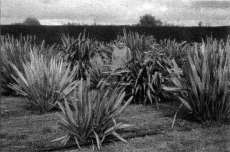 |
| Fig. 2 Sue Scheele, leader of a research programme undertaken by Manaaki Whenua - Landcare Research and Maori weavers on the traditional uses of native plants, with Maori weaving varieties of harakeke (Phormium tenax) growing at Lincoln. |
Much more could be said about the domestication of Phormium. It is important to note that Phormium fibre was for a time New Zealand's most important earner of overseas income. It also needs to be noted that Maori selected and cultivated variegated forms of Phormium for ornamental purposes. An example of this is the variety 'Parekoretawa' adopted for garden use under the name 'Radiance'.
The Coming of Cook
The early European explorers of New Zealand came on the lookout for raw materials and products of value to commerce and trade. This is reflected in Cook's account of his second voyage to New Zealand where he recorded that the most useful plants for future explorers would be harakeke for cordage, rimu for spruce beer and manuka for tea!
In turn, the early European explorers brought domesticated plants that were new to Maori. The most important of these proved to be the potato (Solanum tuberosum) (Fig. 3). It is important to remember that the Northern chief, Ruatara, was the first to make flour from wheat grown in this country. Maori quickly adopted potato as their major cultivated plant, further domesticated it for their own purposes, and were trading it in quantity by 1800. I suggest that those who claim that Maori had the potato before European do Maori a disservice. Had they had this plant, Tasman and Cook would have found the country more heavily and widely populated, and the course of the history of New Zealand would have been very different.
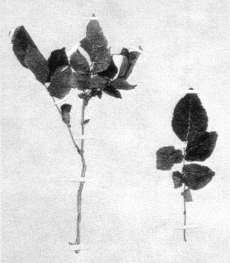 |
| Fig. 3 This herbarium specimen of potato (Solanum tuberosum), collected during Dumont D'Urville's exploration of Tasman Bay in 1827, provides one of the first records of crop plants Europeans introduced to New Zealand. |
Returning to ornamentals, New Zealand plants were brought into garden cultivation in England and Scotland within a decade of Cook's first visit in 1769. That they had also been subjected to varietal selection for garden use in this time is shown by entries for New Zealand tea or myrtle in the 1778 list of greenhouse plants offered by William Malcolm "Nurseryman and Seedman, Near Kennington Turnpike, Surry":
| Philadelphus Aromaticus Latifolia | Broad-leaved Aromatic |
| Philadelphus Angustifolia | Narrow-leaved |
| Philadelphus Hirsutus | Hairy-leaved |
| Philadelphus Lucidus | Shining-leaved |
Descriptions of manuka and kanuka in Solander's unpublished Primitae Florae Novae Zelandiae were named as Philadelphus. It is also on recorded that Robert Anderson of Edinburgh, sometime between 1776 and 1779 offered Philadelphus aromaticus for sale at the princely price of 7s 6d!
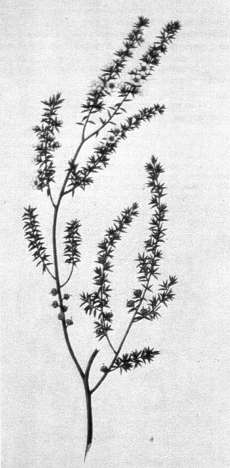 |
| Fig. 4 Illustration of manuka (Leptospermum scoparium) made by Sydney Parkinson, artist on Captain Cook's first voyage to New Zealand. This species, initially included in the genus Philadelphus by the botanist on the voyage Daniel Solander, was grown as a garden plant in England within a decade of Cook's voyage. |
As a generalization it is safe to say that from Cook's time to the beginning of the 20th Century most of the further domestication of New Zealand plants was undertaken in Europe. A notable step was the first artificial hybrid to be raised between two New Zealand native species. This was Hebe ×andersonii 'Andersonii' now regarded as a hybrid between Hebe stricta var. stricta and H. speciosa. Isaac Anderson-Henry of Maryfield near Edinburgh, Scotland raised this hybrid in 1848 and its history is well researched by Peter Heenan (1994). The negative attitude to the use of native plants in the colonial gardens of New Zealand is made clear in Helen Leach's (1994) review of the history of gardening in New Zealand.
However ornamental use of New Zealand native plants in their home country was not entirely overlooked and Potts & Gray (1870) documented the cultivation of some of them in 1870. But it was not until the arrival of Leonard Cockayne that New Zealand plants had a high profile champion for their cultivation and structured domestication.
The Coming of Cockayne
We need to be grateful to Dr A. D. Thomson of the Centre for Studies on New Zealand Science History for the effort he has put into gathering and recording biographical information about Dr Leonard Cockayne. The brief coverage of Cockayne's key contributions to the domestication of New Zealand native plants that I give here is largely derived from his publications about Cockayne (Thomson 1978, 1982, 1983) and the archival records about Cockayne that he maintains.
My interest in Cockayne's work is biased towards his fascination with Leptospermum, his experimental work on the cold hardiness of New Zealand plants, and his involvement with promoting the use of New Zealand plants in gardens overseas. These are all subjects I am involved with in my current research.
Cockayne came to New Zealand in 1881 at the age 25 and was a high school teacher in Otago for three years. An independent income from his father's will allowed him to purchase property at Styx in Canterbury in 1885 where he practiced horticulture. In 1892 he moved from Styx to establish his Tarata Experimental Garden at New Brighton, now a suburb of Christchurch, where he remained until 1903. At 'Tarata' Cockayne gathered plants from around the world and grew them together with native plants. During this time he built up his knowledge about the cultural requirements of native plants and variations in their form, no doubt with a keen eye for those variations that would be of interest to gardeners.
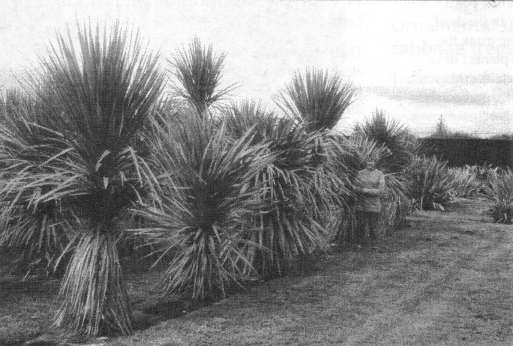 |
| Fig. 5 Leonard Cockayne in the Tarata Experimental Garden at New Brighton, Christchurch. Cockayne lived there from 1892 to 1903, using the garden to study the taxonomy, ecology and cultivation of native plants. |
He gave up his garden 'Tarata' in 1903, and continued to live in Christchurch until 1914. The chronological course of his bibliography in the years 1903 to 1914 indicates that he travelled widely in New Zealand to study native plant communities and devoted a lot of time to writing. Much of this writing was to bring New Zealand plants to the attention of the general public. The foundations of his book 'New Zealand Plants and their Story', the first edition published in 1910, were in the form of a series of 10 articles published in the Lyttleton Times, the Dunedin Evening Star and the Auckland Star in 1906.
Cockayne moved to Wellington in 1914 and took up residence in Ngaio in 1917 where he lived until his death in 1934. During this time he was effectively the defacto Government Botanist, exercising significant national influence over the economic use and conservation of New Zealand plants and their communities. He continued to gather and cultivate native plants in his Ngaio garden although not on the scale he had practiced at 'Tarata'. Rather, his energies were applied to a considerable extent to the establishment of the Otari Open Air Native Plant Museum (now Otari Native Botanic Garden) in 1926.
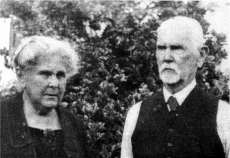 |
| Fig. 6 Leonard and Maude Cockayne at Ngaio in 1932. Leonard Cockayne lived at Ngaio from 1917 until his death in 1934, during which time he was de facto Government Botanist. |
Otari Native Botanic Garden
It is timely to reiterate the four subjects that were to be developed in the scheme for the Otari Garden. These follow the headings given by MacKenzie and Cockayne (1927) in their description of the purpose of the Otari Open Air Native-Plant Museum.
The Flora. A collection of native plant species and their hybrids arranged in order of their taxonomic affinities and in regard to their life forms.
The Vegetation. Presentation of native plants in groupings representing native plant communities.
Horticulture. To show how New Zealand plants could be used in gardens.
Restoration of the original forest. To restore the forest remnant of Wilton's Bush to its original composition.
It is important that these purposes are not perverted to make the priority uses of Otari a pleasure garden and a place to express current vogues of landscape design and architecture with emphasis on visual experience and not the plants.
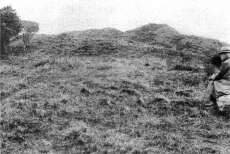 |
| Fig. 7 Cockayne Heights at Otari Open Air Native-Plant Museum in the early years. Leonard Cockayne, who played the key role in defining the purpose of Otari, is probably the person on the right of the photo. |
Cockayne's Contributions to Domestication
Having outlined Cockayne's horticultural history, with this as background it is useful to highlight the steps he took to domesticate New Zealand plants.
Taxonomy. By having a good knowledge of the taxonomy of New Zealand plants he was able to recognise new species when he encountered them, for instance the description of new species of Astelia, Veronica and Celmisia (Cockayne 1899).
Distribution and ecology. Cockayne had an extensive understanding of the distribution and ecology of native species in their natural communities and this was recorded in many publications culminating in 'The Vegetation of New Zealand' (Cockayne 1928). This knowledge was an important precursor to bringing native plants into cultivation.
Bringing plants into cultivation. Cockayne used his knowledge of native plants in the wild to actively bring species into cultivation and to record their suitability as garden plants. This work was brought together in the book 'The Cultivation of New Zealand Plants' (Cockayne 1924a).
Physiological basis of adaptation. Cockayne's first paper in a scientific journal was 'On the freezing of New Zealand alpine plants: notes of an experiment conducted in the freezing chamber, Lyttleton' (Cockayne 1898). This is a pioneering contribution in this field and shows he appreciated the importance of the physiological tolerances of plants in regard to both their ecology and successful cultivation.
Life-forms. Cockayne had a fascination with the life-forms of plants and particularly had an eye for the unusual and characters attractive to horticulturists. His first publication in an overseas journal provides a good example of this — 'On the sudden appearance of a new character in an individual of Leptospermum scoparium' (Cockayne 1907).
Popularisation. Cockayne was very active in disseminating and popularising knowledge about native plants to the public to encourage them to value, conserve, and cultivate them. This was the main purpose of 'New Zealand Plants and their Story' (1910) and the revised editions (1919, 1927).
Promoting overseas use. He promoted the use of New Zealand plants in the gardens of regions outside New Zealand, notably North America (Cockayne 1914a) and the British Isles (Cockayne 1924b).
Wild hybrids. Cockayne was skilled in discerning wild hybrids and meticulous in recording them. He emphasised the systematic and horticultural significance of these hybrids. Published in the year of his death, 'An annotated list of groups of wild hybrids in the New Zealand flora' (Cockayne & Allan 1934), is a classic paper in the annals of botany.
Scientific plant breeding. He advocated the application of scientific plant breeding to advance the domestication of plants as early as 1908. He specifically recommended that it should be applied to Phormium to improve flax fibre production. Cockayne's publications do not indicate that he made artificial hybrids, but his contemporaries and immediate successors in New Zealand botany certainly did. Allan (1926, 1929) published on F1 and F2 crosses of Coprosma and Allan & Zotov (1937) on an artificial cross of Phormium tenax and P. cookianum. There are a good number of more recent artificial hybrids reported.
Lammerts Leap Forward
Cockayne (1907) described the discovery in the wild of red-flowered manuka Leptospermum 'Nichollsii' near Kaiapoi, Canterbury, and later the discovery of a double-flowered white variant that was named L. 'Leonard Wilson' (Cockayne 1918). A colour illustration of L. 'Nichollsii' adorned the cover and provided the frontispiece for 'The Cultivation of New Zealand Plants' (Cockayne 1924a).
A significant step forward in the domestication of New Zealand plants for garden use came in 1939 when Dr W. E. Lammerts in California made a F1 cross that brought together the red-colour and double-petalled character. The F2 progeny of this cross provided a range of flower colours and degrees of doubling as well as variation in flower size, extent of flowering, and habit (Lammerts 1945). This unleashed the proliferation of ornamental cultivars of Leptospermum, which numbered 140 in 1991 and has increased considerably since.
Metcalf Milestones
With the proliferation of ornamental cultivars of native plants there was a need to keep track of them by the preparation of checklists. Lawrie Metcalf and the Nomenclature Committee of the Royal New Zealand Institute of Horticulture began this in 1963 with a list of 76 cultivar names for Leptospermum. Peter Heenan has put together checklists for Sophora, Cordyline and Phormium since. A checklist of Hebe cultivars primarily compiled by Lawrie Metcalf is close to publication and will include near to 1000 valid names and synonyms. This work is critical to keep track of the progress of the domestication of New Zealand plants.
The first edition of Lawrie Metcalf's book 'The Cultivation of New Zealand Trees and Shrubs' published in 1972 is an important milestone in the progress of domestication of New Zealand plants for garden use. In his introduction to the book he acknowledges the significance of Cockayne's 'The Cultivation of New Zealand Plants'. It is important to remember that Cockayne covered the full gamut of trees, shrubs, climbers, herbs, grasses and ferns in a small book. Now we have a selection of books specifically dealing with these various categories of plants, and Metcalf's The Cultivation of New Zealand Native Grasses' published in 1998 is amongst the most recent of these.
A strength of 'The Cultivation of New Zealand Trees and Shrubs' is that Metcalf used, and gave due acknowledgement to, plant taxonomic research and the consolidation of that in the Flora of New Zealand series. That he does not do this in the book on grass cultivation can be excused by the fact that Volume V of the Flora Series on New Zealand Grasses, written by Dr Elizabeth Edgar and Dr Henry Connor, was not published until January 2000.
Current Domestication of Native Plants
There is a lot happening currently towards the further domestication of native plants. I will not attempt to review this work here as I would inevitably overlook some important contributors and several of them are present at this conference. What is clear is that New Zealand nurserymen have a keen eye for variants of native plants. Where they have considered the variants would be of interest to gardeners they have been effective in propagating these, naming them for commercial purposes, and marketing them.
In recent years there has been a more scientifically structured approach to the breeding, selection and development of native plants for horticultural use, undertaken by people in different agencies. As the person on the platform I will give some examples of this from my own work, focussing on Leptospermum and aspects of this genus that would have fascinated Cockayne.
Hybrids
Cockayne and Allan speculated on the possibility of hybrids between manuka (Leptospermum scoparium) and kanuka (L. ericoides) (Cockayne & Allan 1934). In 1983 the Australian taxonomist Joy Thompson transferred kanuka to Kunzea lumping together in K. ericoides the Great Barrier Island endemic L. sinclairii and Australian plants formerly classified under L. phylicoides and other names.
While studying, within species variation of New Zealand manuka and kanuka, I came across a plant in a population of Kunzea sinclairii from Mt Hobson, Great Barrier Island that had characteristics intermediate between this species and L. scoparium. This has been confirmed as a sterile intergeneric hybrid and has been named ×Kunzspermum hirakimata. (Fig. 8). Anticipating this plant might be of interest to gardeners it has been given the cultivar name 'Karo Hobson Choice' (Harris 1993).
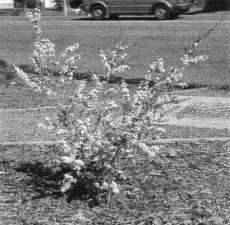 |
| Fig. 8 Kunzspermum hirakimata 'Karo Hobson Choice', the intergeneric hybrid between manuka (Leptospermum scoparium) and the Great Barrier Island endemic kanuka (Kunzea sinclairii). |
Cockayne & Allan (1934) noted as remarkable the occurrence of hybrids between New Zealand and Australian Olearia species in gardens in Scotland and New Zealand. In the course of studies of Leptospermum at Landcare Research, first a chance hybrid between two Australian species was discovered (Harris et al. 1995), and subsequently deliberate crosses were made between other Australian species. Plant variety rights have been taken out on three of these hybrids and these have been released as the commercial cultivars L. 'Karo Spectrobay', L. 'Karo Silver Ice' and L. 'Karo Pearl Star'.
Related to these studies at Landcare Research, Murray Dawson has produced hybrids between the Australian species L. spectabile and the L. scoparium cultivar 'Pink Lady'. Recently, crosses made by Crop & Food Research Institute have produced a new hybrid cultivar derived from L. scoparium and the Australian species L. rotundifolium and released as the Galaxy series. In the domestication of Leptospermum these interspecific hybrids rank in importance with the discovery of red-flowered manuka and Lammert's F2 hybrid cultivars.
Cockayne was fascinated with plant form, and was especially intrigued by the variation and plasticity of manuka. It is a theme he returns to several times in 'New Zealand Plants and their Story' (Cockayne 1910). An extreme form of habit variation is the marked change from a divaricate juvenile form to a non-divaricate adult form that is expressed by 11 New Zealand species. This is known as habit heteroblastism (Philipson 1964).
Another significant step in the ornamental diversification of Leptospermum was the development by Duncan & Davies, New Plymouth, of the 'Nanum' series of cultivars named after New Zealand birds. I have used these dwarf cultivars in crosses with Australian Leptospermum species, the first between L. 'Huia' and a small prostrate form of the Tasmanian subalpine species L. rupestre. From the progeny of this cross made in 1990 a dwarf-prostrate pink-flowered floriferous selection has been made that makes a very attractive pot or rockery plant. This plant has been given the name L. 'Lilliput' (Fig. 9), but it is slow growing and commercial propagators have not yet taken it up.
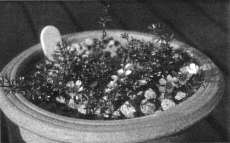 |
| Fig. 9 Leptospermum 'Lilliput' a dwarf-prostrate pink flowered hybrid between a small prostrate form of the Tasmanian subalpine species L. rupestre and the nanum cultivar L. scoparium 'Huia'. |
In 1993 I made a series of crosses of a range of Australian species using the erect red-flowered cultivar L. 'Donna' selected by Jack Hobbs and the dwarf 'Nanum' cultivar L. 'Kiwi' as the seed parents. The progeny of the 'Kiwi' crosses produced a proportion of dwarf plants similar to the seed parent. But unexpectedly, some of these dwarf plants have abruptly produced erect shoots that are similar to the pollen parent (Fig. 10). This has been most apparent in a cross using L. lanigerum as the pollen parent. In effect these plants are showing habit heteroblastism.
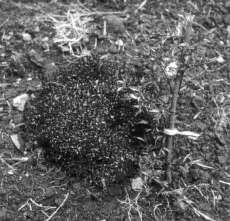 |
| Fig. 10 An adult shoot arising from the nanum form of a hybrid between Leptospermum scoparium 'Kiwi' and the Australian species L. lanigerum. The adult shoot grew to overwhelm the nanum phase of the plant. |
This characteristic has also been shown by the 'Nanum' cultivars, but has been dismissed as 'reversion'. The indication is that it is a genetically controlled character and that 'pure stable dwarf forms' could be selected. It also indicates that the plasticity of manuka in the wild that fascinated Cockayne has a definite genetic as well as an environmental component.
Cold Hardiness and Selection for use in Overseas Gardens
In promoting the use of New Zealand plants in the gardens of the British Isles and North America Cockayne was very mindful of their limited cold hardiness. In 1986 Luc Decourtye a leading French breeder of fruit trees and woody ornamental plants came to New Zealand seeking material to diversify the range of ornamental plants available in France. He focussed his attention on plants of the higher, inland parts of the South Island.
I provided Decourtye with seed from the collection of provenances of L. scoparium from a wide latitudinal and altitudinal range in New Zealand that were then growing at Lincoln. Decourtye raised plants from this seed and grew the plants at three localities in France with contrasting winter temperature regimes (Fig. 11). This study showed marked variation of cold tolerance within L. scoparium that was related to the origin of the provenances (Harris and Decourtye 1991, Decourtye and Harris 1992). It showed that breeding and selection could markedly extend the range and reliability of use of New Zealand plants in the gardens of Europe and North America.
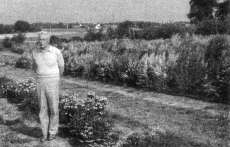 |
| Fig. 11 Luc Decourtye with New Zealand provenances of Hebe (foreground) and Leptospermum (background) under evaluation for cold hardiness at Angers, France. |
Essential Oils
Extraction of economic products from New Zealand plants in sustainable systems has had a chequered history. Both the flax fibre and the Solanum laciniatum alkaloid solasodine industries came to an end through the combined effects of plant disease, undercutting by cheap third world labour, and substitution by synthetics.
However there is hope for an essential oil industry based on the New Zealand tea-trees especially from an East Coat manuka chemotype which has pharmacologically effective oils. Assays undertaken by the Plant Extracts Research Unit of Crop & Food Research, of the manuka and kanuka provenances from Australia and New Zealand that I assembled at Lincoln showed significant regional variation of essential oil content (Perry et al. 1997a, b).
I believe that for this sunrise industry to have a sustainable future there needs to be further domestication of these tea-trees by breeding, including interspecific hybrids, and selection for improved yield of the desired oil constituents. The undesirable alternative is an exploitative non-sustainable industry providing a product of unreliable quality.
Future Prospects for Domestication
Cockayne's contributions to New Zealand were built on his British heritage and particularly his knowledge of English gardening (Thomson 1983). These influences remained with him to his death. It is recorded that he said late in life that if he had his time over again he would have been a breeder of lilies! His first public lecture in New Zealand, given in 1892, was entitled 'The Daffodil'. It is recorded that at this lecture he recited Wordsworth's well-known poem 'Daffodils' that starts:
I wander'd lonely as a cloud
That floats on high o'er vales and hills'
So if Cockayne could allow himself such poetic license so can I to introduce the points of this final section.
We wandered lonely in the cloud
That floats along as Aotearoa
Where all we saw were
Blighted manuka,
Yellowing harakeke, and
Declining cabbage trees —
Beside the pasture,
Beneath the Pinus radiata,
Faltering and dying
In the roaring fourties
Of course this is a very pessimistic outlook for the future, but in view of what has happened to native plants and their communities in recent decades, it could become true if we do not persist with remedial actions.
In looking to the future I make four points:
Pests and diseases. There is no doubt that our native species are becoming victims of new pests and diseases or are being grown in situations that make them more prone to old ones. Breeding and selection for resistance to these is a good option to overcome this problem. It may be necessary to look for resistance in related overseas species as has already been done for Leptospermum.
Conservation of alleles of genes. I have asked people if there are any plant genes endemic to New Zealand. The answer to this question is probably no, but there are likely to be many alleles of genes endemic to this country (alleles are alternative states of a gene, for example those determining variants of flower petal colour).
Our focus for plant conservation has been on saving rare and endangered species from extinction. Common widespread species are ignored in this respect. But it is very likely that these common species contain rare alleles prone to extinction.
Consequently it is important to conserve populations of widespread species that are representative of their full environmental range and genetic variation. That way we are more likely to retain the genetic building blocks needed for further domestication of native plants.
Domestication for restoration. An important theme of this conference is the restoration and management of native vegetation. Effectively this involves processes of domestication as native plants and their communities are being used to satisfy human needs and aspirations.
We have to accept that we cannot return native vegetation to its primeval state. In the span of human affairs the primeval environment of New Zealand has been irreversibly changed — in fact it was never constant.
For example, phosphate fertilization has brought about widespread changes to our soils and native plants have difficulty in competing with plants that have evolved in phosphate rich soils. To save native plants in natural communities we will have to actively assist their adaptation to these changed conditions.
The greatest economic value of native plants. In our review of the Domestication of the New Zealand Flora Peter Heenan and I concluded "It is through their conservation in natural communities by long term support and further enhancement of the New Zealand parks and reserves systems, that New Zealand plants will have their greatest economic realisation." (Harris & Heenan 1992).
Cockayne had expressed very similar opinions at the 1901 Conference of New Zealand Fruitgrowers and Horticulturists (Thomson 1978). To quote:
"The most valuable asset in our colony was the scenery, and if we destroyed our forests the scenery would be no longer an asset" and "... it was of as much importance to look after their native plants as the fruit industry".
To end, this one page publication of Cockayne's (1914b) that appeared in The New Zealander in 1914 speaks for itself:
The Bush a Priceless Possession
However little the average New Zealander may know about the plants of his country, few there are who cannot raise some enthusiasm regarding the "bush," as the forest is everywhere called. To old and young it is a delight - the stately trees; the birds, fearless of man; and above all, the wealth of ferns appeal to all. But that this forest is a unique production of nature, found in no other land, is not a matter of common knowledge, though truly it has many claims to be considered a priceless possession.
References
Allan, H. H. 1926: The F1 progeny resulting from the crossing of Coprosma propinqua and C. robusta. Genetica 8: 155-160.
Allan, H. H. 1929: The F2 progeny resulting from the crossing of Coprosma propinqua and C. robusta. Genetica 11: 335-346.
Allan, H. H. and Zotov, V. D. 1937: An artificial cross between Phormium colensoi and P. tenax. New Zealand journal of science and technology 18: 799-804.
Cockayne, L. 1898: On the freezing of New Zealand alpine plants: notes of an experiment conducted in the freezing-chamber, Lyttleton. Transactions and proceedings of the New Zealand Institute 30: 435-442.
Cockayne, L. 1899: Descriptions of new species of Astelia, Veronica, and Celmisia. Transactions and proceedings of the New Zealand Institute 31: 424-426.
Cockayne, L. 1907: On the sudden appearance of a new character in an individual of Leptospermum scoparium. New Phytologist 6: 43-46.
Cockayne, L. 1910: New Zealand Plants and their Story. Wellington, Government Printer. 190 pp. (1919 2nd Edition), (1927 3rd Edition).
Cockayne, L. 1914a: New Zealand Plants Suitable for North American Gardens. Panama Pacific International Exposition, San Francisco, USA, February-December, 1915, Wellington, Government Printer. 35 pp.
Cockayne, L. 1914b: The bush a priceless possession. The New Zealander 1: 2.
Cockayne, L. 1918: Notes on New Zealand floristic botany, including descriptions of new species &c. Transactions and proceedings of the New Zealand Institute 50: 161-191.
Cockayne, L. 1924a: The Cultivation of New Zealand Plants. New Zealand Practical Handbooks. Christchurch, Whitcombe & Tombs. 139 pp.
Cockayne, L. 1924b: New Zealand plants for the British Isles. The garden 88: 615-616; 632-633; 646-647; 660-662.
Cockayne, L. 1928: The Vegetation of New Zealand. Leipzig, Wilhelm Engleman. 456 pp.
Cockayne, L. and Allan, H. H. 1934: An annotated list of groups of wild hybrids in the New Zealand flora. Annals of botany 48: 1-55.
Decourtye, L. and Harris, W. 1992: Selection for cold resistance in Leptospermum scoparium (J.R. et G. Forst.). Acta Horticulturae 320: 39-43.
Harris, W. 1993: ×Kunzspermum hirakimata 'Karo Hobson Choice' — a new intergeneric hybrid tea tree cultivar. Horticulture in New Zealand 4(2): 10-12.
Harris, W. and Decourtye, L. 1991: Winter climatic comparison between France and New Zealand: effects of frost damage on populations of Leptospermum scoparium J.R. et G. Forst. grown at three locations in France. Agronomie 11: 847-861.
Harris, W. and Heenan, P. B. 1991: Cordyline 'Ti Tawhiti' and its relationship to Cordyline 'Thomas Kirk'. Horticulture in New Zealand 2: 2-5.
Harris, W. and Heenan, P. B.1992: Domestication of the New Zealand flora — an alternative view. New Zealand journal of crop and horticultural science 20: 257-271.
Harris, W.; Dawson, M. I. and Heenan, P. B. 1995: Opportunities for Leptospermum hybrid ornamental cultivars and a new ornamental cultivar — Leptospermum ×violipurpureum 'Karo Spectrobay'. Horticulture in New Zealand 6(1): 3-8.
Heenan, P. B. 1994: The origin and identification of Hebe ×andersonii and its cultivars (Scrophulariaceae). Horticulture in New Zealand 5(1): 21-25.
Lammerts, W. E. 1945: New double flowering Leptospermum hybrids. Journal of the Californian Horticultural Society 6(3): 250-257.
Leach, H. 1994: Native plants and national identity in New Zealand gardening: an historical review. Horticulture in New Zealand 5(1): 28-33.
MacKenzie, J. G. and Cockayne, L. 1927: The Otari Open Air Native-Plant Museum. Bulletin of the New Zealand Institute of Horticulture 1(4): 1-13.
Metcalf, L. J. 1972: The Cultivation of New Zealand Trees and Shrubs. Auckland, Reed Methuen.
Metcalf, L. J. 1998: The cultivation of New Zealand Native Grasses. Auckland, Random House.
Metcalf, L. J. and Nomenclatural Committee of the Royal New Zealand Institute of Horticulture 1963: Checklist of Leptospermum cultivars. Journal of the Royal New Zealand Institute of Horticulture 5: 224-230.
Molloy, B. 1990: The origin, relationships, and use of karaka or kopi (Corynocarpus laevigatus). In: Nga Mahi Maori o te Wao Nui a Tane: contributions to an International Workshop on Ethnobotany. Harris, W.; Kapoor, P. eds. Christchurch, Botany Division, DSIR. Pp. 48-53.
Perry, N. B.; Brennan, N. J.; van Klink, J. W.; Harris, W.; Douglas, M. H.; McGimpsey, J. A.; Smallfield, B. M. and Anderson, R. E.1997b: Essential oils from New Zealand manuka and kanuka: chemotaxonomy of Leptospermum. Phytochemistry 44: 1485-1494.
Perry, N. B.; van Klink, J. W.; Brennan, N. J.; Harris, W.; Anderson, R. E.; Douglas, M. H. and Smallfield, B. M. 1997b: Essential oils from New Zealand manuka and kanuka: chemotaxonomy of Kunzea. Phytochemistry 45: 1605-1612.
Philipson, W. R. 1964: Habit in relation to age in New Zealand trees. Maheshwari commemorative volume, Journal of the Indian Botanical Society 42A: 167-179.
Potts, T. H. and Gray, W. 1870: On the cultivation of some species of native trees and shrubs. Transactions and proceedings of the New Zealand Institute 3: 181-202.
Thomson, A. D. 1978: Leonard Cockayne: horticulturist. New Zealand journal of botany 16: 397-404.
Thomson, A. D. 1982: A bibliography of the work of Leonard Cockayne. New Zealand journal of botany 20: 205-219.
Thomson, A. D. 1983: The Life and Correspondence of Leonard Cockayne. Christchurch, Caxton Press. 55 pp.
Thompson, J. 1983: Redefinitions and nomenclatural changes within the Leptospermum suballiance of Myrtaceae. Telopea 2(4): 379-383.
![]()
- View
this paper as a PDF of the original proceedings

- Full
conference proceedings available as a hardcopy from the RNZIH
Reproduced from: New Zealand Plants and their Story
Proceedings of a conference held in Wellington, 1-3 October 1999
ISBN 0-9597756-3-3
Home | Journal
| Newsletter | Conferences
Awards | Join
RNZIH | RNZIH Directory | Links
© 2000–2025 Royal New Zealand Institute of Horticulture
Last updated: April 25, 2004

